Integral Management of Sargassum Seaweed
Sargassum is a type of macroalgae or seaweed that forms large floating mats in the open ocean, primarily in a region known as the Sargasso Sea in the North Atlantic Ocean.
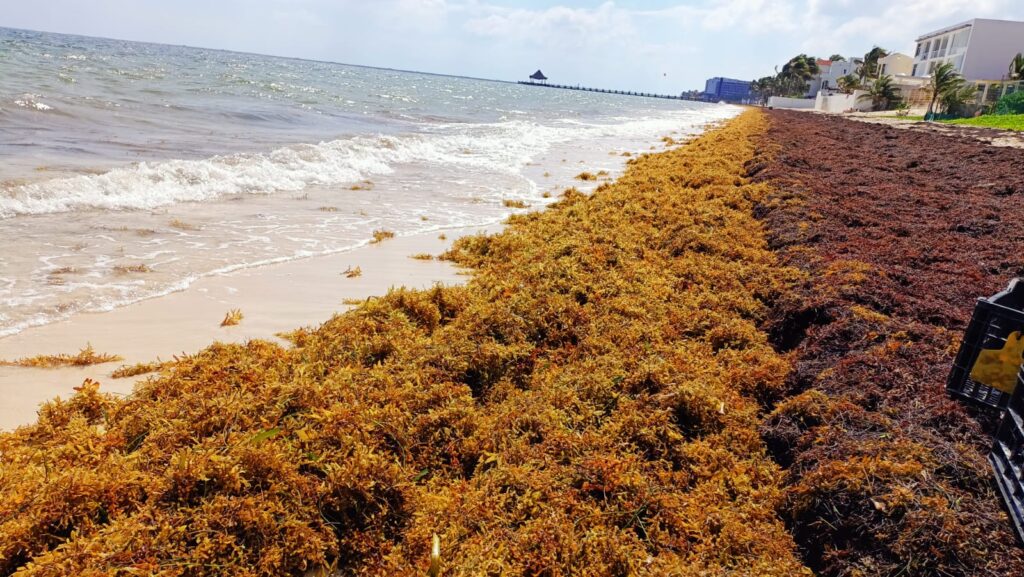
While Sargassum may sometimes be viewed negatively due to its periodic influxes on coastlines, it also plays important roles in marine ecosystems and has various ecological and environmental significance:

Habitat and Nursery Grounds
Sargassum mats serve as unique habitats and nursery grounds for various marine species. Juvenile fish, sea turtles, and other marine organisms find shelter, food, and protection within these floating ecosystems.

Biodiversity
The Sargassum habitat supports a diverse array of species. Many organisms, from tiny invertebrates to larger fish and seabirds, use Sargassum mats for feeding, shelter, and breeding, contributing to local and regional biodiversity.

Oceanic Ecosystems
Sargassum plays a role in connecting surface and open-ocean ecosystems. It creates a distinct ecosystem that provides a habitat and foraging area for organisms that wouldn't have other floating habitats in the open ocean.

Carbon Cycling
Sargassum contributes to carbon cycling and the marine carbon sink. It absorbs carbon dioxide from the water as it photosynthesizes, helping to regulate atmospheric carbon levels.

Source of Organic Matter
As Sargassum mats decay, they release organic matter into the water. This organic matter forms the basis of marine food webs, providing nutrients and energy for various marine organisms.

Nutrient Cycling
As Sargassum breaks down, it releases nutrients back into the water, which can contribute to nutrient cycling in the ocean and support productivity in marine ecosystems.

Research and Education
Sargassum mats offer opportunities for scientific research and educational experiences. Researchers study these mats to understand ocean dynamics, species interactions, and the ecological functions of open-ocean habitats.

Cultural and Historical Significance
The Sargasso Sea, where these mats primarily occur, has a historical and cultural significance. It has been referenced in literature and folklore, contributing to our understanding of the ocean's mysteries.

Conservation and Environmental Monitoring
Monitoring the distribution and abundance of Sargassum mats can provide insights into ocean health and ecosystem dynamics. Sudden influxes of Sargassum onto coastlines can indicate changes in ocean currents and environmental conditions.

Climate Change and Adaptation
As ocean conditions change due to climate change, the presence and distribution of Sargassum mats might be affected. Understanding these changes can provide valuable information for adapting to the evolving ocean environment.
Sargassum Biochar
Biochar is a charcoal produced through the pyrolysis of organic materials, such as wood, agricultural residues, and other biomass. Pyrolysis is a process that involves heating biomass in the absence of oxygen, which prevents complete combustion and results in the creation of biochar. This process produces a stable, carbon-rich material that can be used for various applications, including soil improvement, carbon sequestration, and environmental remediation
Biochar from sargassum involves the conversion of seaweed biomass into biochar through a process called pyrolysis. Pyrolysis is the thermal decomposition of organic materials in the absence of oxygen, resulting in the production of char, gases, and liquid byproducts. In the case of sargassum, this process can transform the biomass into a stable form of carbon-rich material known as biochar.
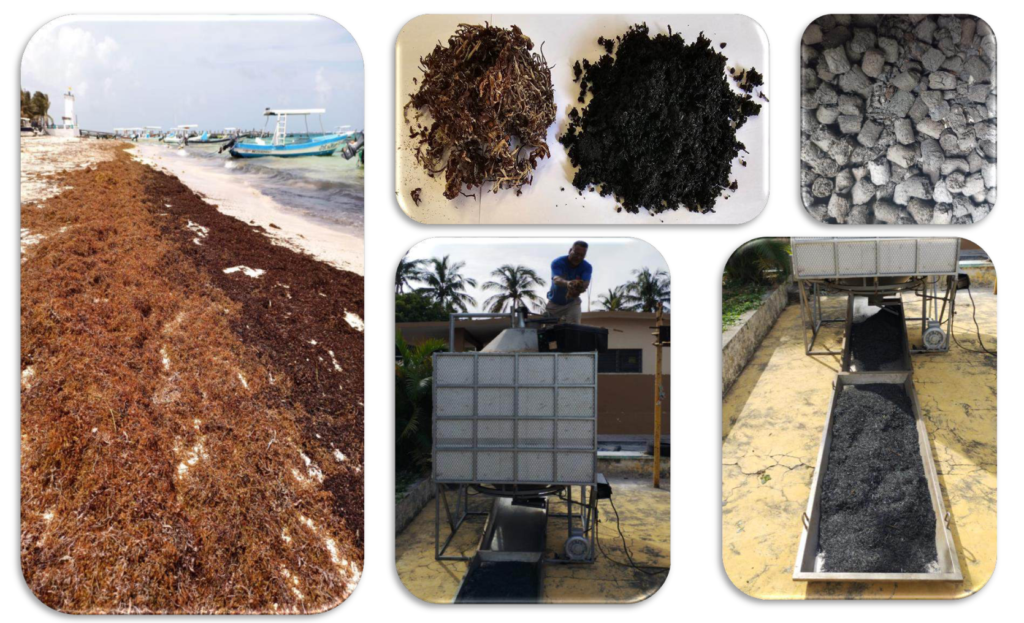
Overall, biochar is known for its unique physical and chemical properties that make it beneficial for agricultural and environmental purposes. Some key characteristics of biochar include:

Carbon Sequestration
Biochar is a form of stable carbon that can remain in soils for a long time. When added to soil, it can help sequester carbon, thereby reducing atmospheric carbon dioxide levels and mitigating climate change.

Soil Improvement
Biochar can enhance soil structure and fertility. It improves water retention, nutrient availability, and microbial activity in soils. It can also increase cation exchange capacity, leading to improved nutrient retention and plant growth.

Nutrient Retention
Biochar has the ability to adsorb and retain nutrients, preventing their leaching into groundwater and improving nutrient-use efficiency by plants. This is especially important for sustainable agriculture.

pH Regulation
Depending on its source and production conditions, biochar can influence soil pH. Some types of biochar can act as a liming agent, helping to raise soil pH in acidic soils.

Water Management
Biochar-amended soils have improved water-holding capacity, which can be beneficial for both water-stressed and waterlogged conditions. This property can help mitigate drought stress and reduce soil erosion.

Microbial Habitat
Biochar provides a habitat for beneficial soil microorganisms. Its porous structure can harbor microorganisms that contribute to nutrient cycling and improve soil health.

Contaminant Remediation
Biochar has been used in environmental remediation to adsorb and immobilize contaminants, such as heavy metals and organic pollutants, in soils and water.

Waste Utilization
Biochar production can provide an outlet for agricultural and forestry residues, reducing waste and providing a value-added product.
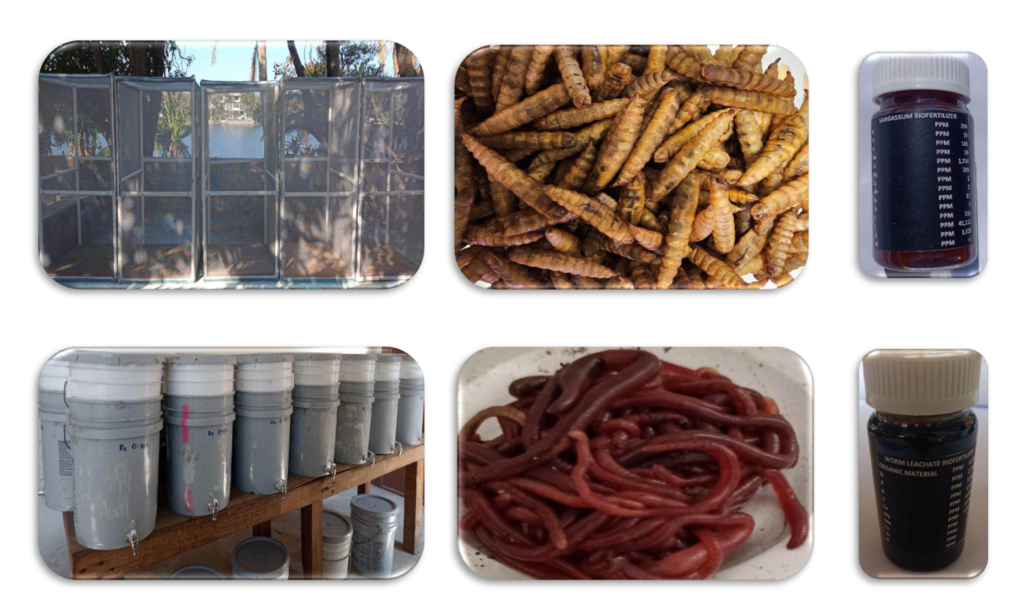
Sargassum Biofertilizers and Biostimulants
Sargassum biofertilizers and biostimulants are organic fertilizers and biological enhancers made from Sargassum seaweed. Biofertilizers and biostimulants derived from sargassum, often referred to as sargassum-based compounds, are organic extracts of sargassum seaweed biomass. These compounds are rich in nutrients, growth-promoting substances, and beneficial microorganisms that can enhance plant growth and improve soil health.
The nutrients present in Sargassum, such as nitrogen, phosphorus, and potassium, along with trace minerals and other organic compounds, can help enhance soil fertility and promote plant growth. Sargassum-based biofertilizers and biostimulants offer several potential benefits:

Nutrient Enrichment
Sargassum is naturally rich in essential nutrients such as nitrogen, phosphorus, potassium, and trace minerals, which are important for plant growth.

Plant Growth Promoters
Sargassum extracts could contain natural plant growth regulators like auxins, cytokinins, and gibberellins, which can stimulate root development, flowering, and overall growth.

Stress Resistance
Sargassum-based biofertilizers can enhance a plant's resistance to various stresses, including drought, salinity, and disease.

Soil Conditioning
The organic matter in Sargassum can improve soil structure, water-holding capacity, and microbial activity, leading to healthier and more productive soil.

Slow Release
Sargassum biofertilizers may release nutrients gradually, reducing the risk of nutrient leaching and runoff.

Sustainability
Utilizing Sargassum for biofertilizers can help repurpose seaweed that washes up on beaches, contributing to waste reduction.

Environmentally Friendly
Organic biofertilizers like those made from Sargassum are less likely to contribute to water pollution and environmental harm compared to synthetic chemical fertilizers. These fertilizers are often considered environmentally friendly due to their renewable source and potential to reduce the reliance on synthetic chemical fertilizers.
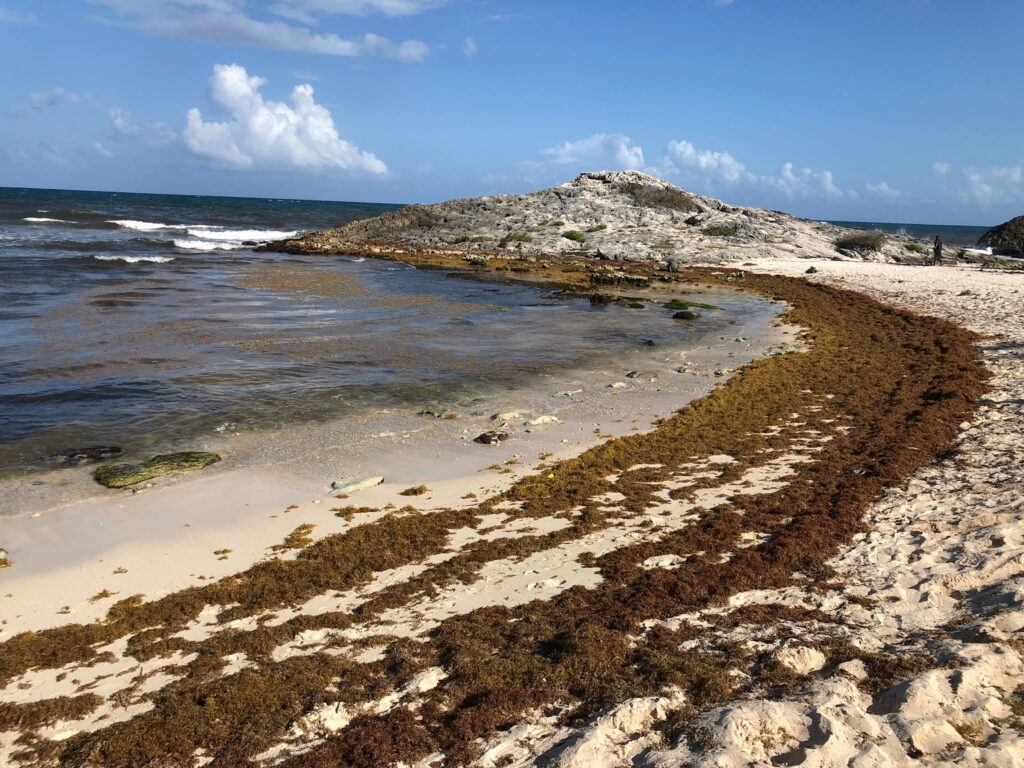
Sargassum Bioplastics
Sargassum bioplastics refer to biodegradable plastics that are made from Sargassum. These bioplastics are produced using the biomass of Sargassum through processes that involve extraction, purification, and conversion of its components into plastic materials.
Sargassum bioplastics offer several potential benefits:

Renewable Resource
Sargassum is a naturally abundant resource, and its utilization for bioplastics reduces the reliance on fossil fuels and non-renewable resources used in traditional plastics.

Biodegradability
Unlike conventional plastics, Sargassum bioplastics are designed to break down more quickly in the environment, potentially reducing plastic pollution and its negative impacts on marine ecosystems.

Reduced Carbon Footprint
The production of Sargassum bioplastics may have a lower carbon footprint compared to conventional plastics, contributing to climate change mitigation efforts.

Local Economic Opportunities
Utilizing Sargassum for bioplastics could provide economic opportunities for coastal communities, helping to manage Sargassum influxes that can impact beaches and marine environments.

Versatility
Sargassum bioplastics can potentially be used in various applications, from packaging materials to single-use items like cutlery and straws.
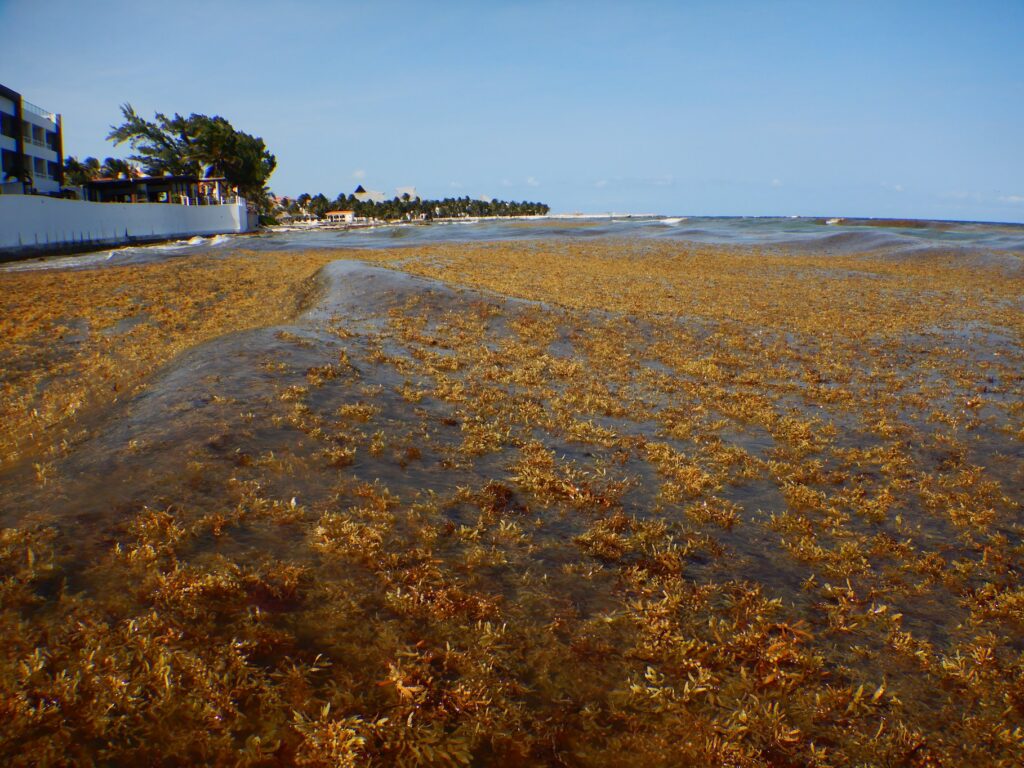
Sargassum Bioactive Compounds
Sargassum, a type of brown macroalgae (seaweed), contains a variety of bioactive compounds that have potential applications in various fields, including pharmaceuticals, food, cosmetics, and agriculture.
Some of the bioactive compounds found in Sargassum include:

Phenolic Compounds
Sargassum species are rich in phenolic compounds, which have antioxidant properties and potential health benefits. These compounds can help protect cells from oxidative stress and are being investigated for their anti-inflammatory, anti-cancer, and cardiovascular benefits.

Polysaccharides
Sargassum contains polysaccharides with various biological activities. These polysaccharides can have immunomodulatory effects, promoting immune system health. They also show potential for wound healing, anti-inflammatory actions, and as ingredients in cosmetics.

Fucoidans
Fucoidans are sulfated polysaccharides found in Sargassum and other brown seaweeds. They have anticoagulant, antiviral, and antioxidant properties. Fucoidans are being studied for their potential in cancer therapy, immune modulation, and other health applications.

Lipids
Sargassum contains lipids (fats) with potential nutritional value. These lipids might serve as sources of omega-3 fatty acids, which are known for their positive effects on heart health and inflammation reduction.

Pigments
Sargassum species contain various pigments, including chlorophylls, carotenoids, and phycobiliproteins. These pigments have potential applications in the food and cosmetic industries as natural colorants and antioxidants.

Sterols
Sargassum species also contain sterols, which are compounds with structural and functional roles in cells. Some sterols have shown potential for their anti-inflammatory and cholesterol-lowering effects.
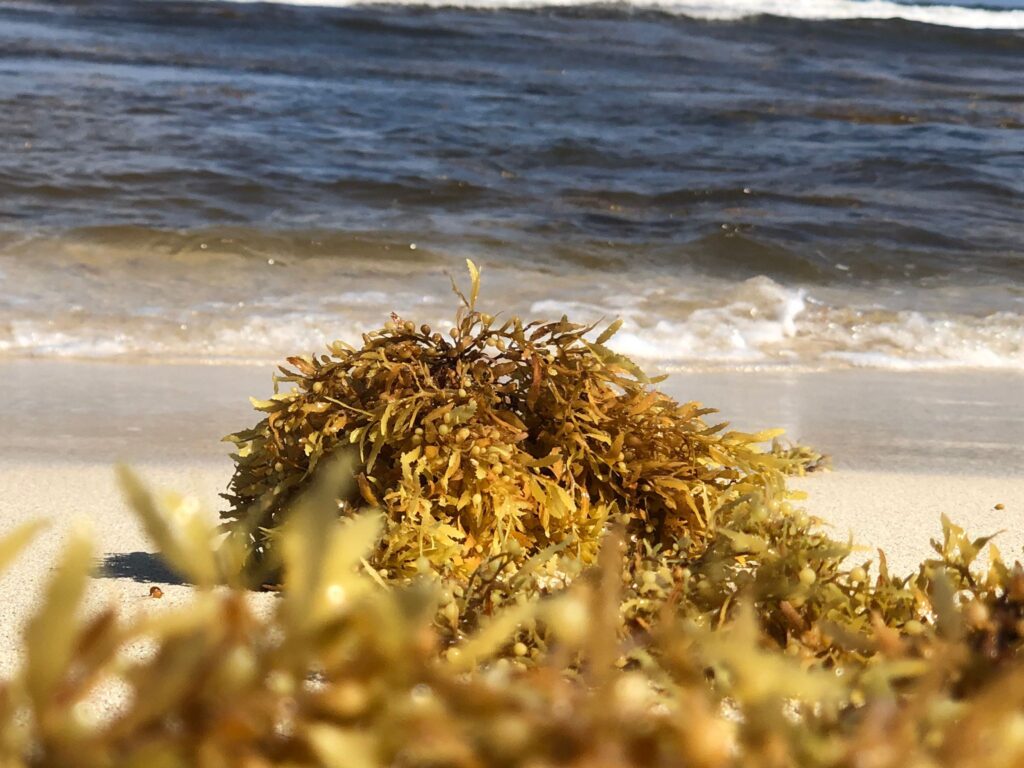
Sargassum Alternative Proteins
Sargassum insect protein refers to the utilization of Sargassum seaweed as a potential feed source for insects that are then harvested for their protein content. Insects are being explored as a sustainable and protein-rich alternative for animal feed and potentially even human consumption. Sargassum seaweed, known for its nutrient content, could be used to support the growth of insects intended for protein production.
The process might involve cultivating insects such as crickets, mealworms, or black soldier flies on a diet that includes Sargassum seaweed. As the insects consume the seaweed, they accumulate its nutrients, including proteins, fats, and minerals. These insects are then harvested and processed into insect-based protein products.
